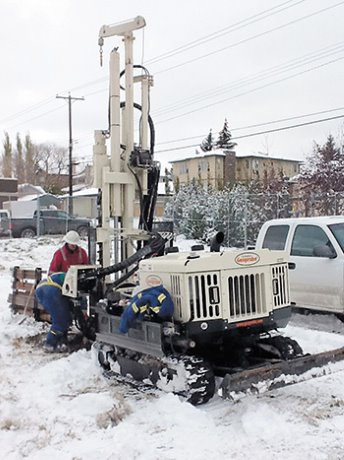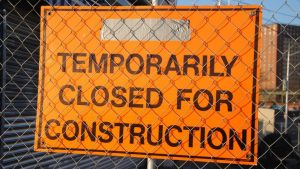The science of environmental soil sampling and remediation spurred demand for a whole new set of tools.
Geoprobe Systems of Salina, Kansas entered that market in 1987, with a series of small profile direct push drill rigs that provided an alternative to augers.
Today the drills perform tasks that range from soil sampling to the direct injection of soil remediation chemicals such as oxidizers, and complex analyses of groundwater systems and contaminants.
The small size of the rigs allows them to be operated in close quarters, among industrial equipment or in challenging urban environments.
“The product line has developed many new applications, largely because clients have asked us whether the machines can do one thing or another,” said Greg Johnson, international sales co-ordinator with Geoprobe.
One development is the Membrane Interface Probe, which tests soils for volatile organic compounds (VOCs).
When heat is inducted into the soil, it vapourizes VOC molecules, which penetrate a semi-permeable membrane that keeps groundwater out.
The VOCs are then driven into a gas chromatograph using inert nitrogen gas.
The newest probe is the Hydraulic Profiling Tool (HPT), which measures the pressure required to inject water into the soil as the probe advances into the ground.
“By determining how much pressure is required to inject the water, we can develop a hydraulic profile of the subsurface,” said Johnson.
“In tight clay the water would go nowhere, but in loose gravel the water will move more freely. This not only tells us about the groundwater flows, but helps us locate the areas to inject remediation products, so that they’ll best be able to chase and eliminate contaminants.”
G&R Remediation/Enviro Core is a remediation and drilling company located in Lacombe, Alberta near Red Deer.
It has offered direct push drilling since 2001.
“Our first remediation job was on property I owned that had been contaminated by a former gas station,” said manager Ray Barritt.
“The consultants gave us three remediation options, one of which was injection of oxygen products into the soil. At that time, there were no contractors in Alberta that supplied direct push services, so we built a direct push unit ourselves and completed the job on our own.”
The company has since amassed a fleet of specialty equipment, including the Geoprobe line and an array of direct-sensing tools.
Barritt said that the country was slow to warm to the concept of direct push sampling and soil remediation when it was introduced.
“Canadians tend to be skeptical when a new concept comes around, so for the first few years of operation it was a long, hard process to develop direct push sampling as a mainstay of the business,” he said.
“On the remediation side, there are many places in Canada, where it’s reasonably cheap to go the dig-and-dump route, taking contaminated soil to designated landfills.”
However, when a client has to choose between in situ soil remediation and excavating underneath the foundation of a building or in a difficult-to-access area, dig-and-dump may lose its lustre.
“We do quite a bit of injection remediation beneath chemical warehouses or dry cleaning establishments, either drilling from an angle outside or directly through the sub-floor of the building,” said Barritt.
“We can take our smallest Geoprobe through a 34-inch basement door.”
G&R is also the first company in Canada to acquire a Geoprobe HPT attachment.
“In addition to supplying groundwater depth and the rate of velocity that groundwater may move a contaminant plume over time, an HPT with electrical conductivity (EC) capabilities also provides information on the EC of contaminants in the soil,” said Barritt.
“For example, in Alberta, if we have a site that may have salt contamination issues, possibly from a brine pond, and if EC levels are high, that’s probably what it is.”
A recent client proved a perfect candidate for the HPT.
“We’ve worked for the Alberta Ministry of Transportation on a number of sites, where they store road salt,” he said.
“You can’t get a better technology fit than that.”











Recent Comments
comments for this post are closed